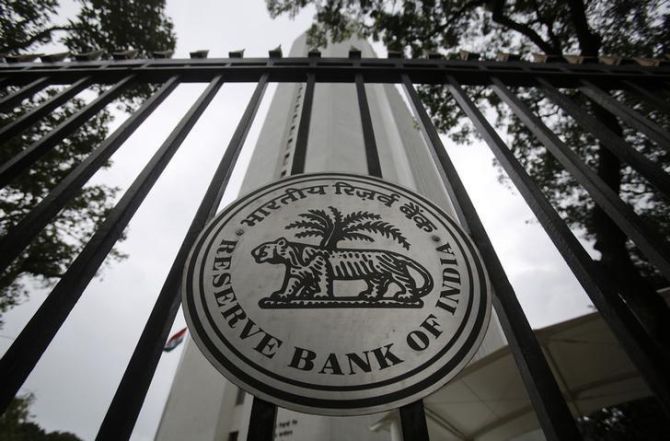 | « Back to article | Print this article |
The deadline for officers to decide on their career path in the biggest organisational rejig in the central bank’s 85-year history ends on January 31.
The immediate fallout could be its disruptive impact on the supervisory process for 2020 -- and beyond -- given the manpower shortfall, even as more entities are set to come under closer central bank scrutiny.

The Reserve Bank of India is heading towards a human resource crisis, with a majority of its officers indicating to their reporting heads that they want to opt out of the unified regulatory and supervisory cadre, which came into effect from November 1, 2019.
The deadline for officers to decide on their career path in the biggest organisational rejig in the central bank’s 85-year history ends on January 31.
The immediate fallout could be its disruptive impact on the supervisory process for 2020 -- and beyond -- given the manpower shortfall, even as more entities are set to come under closer central bank scrutiny.
The turmoil is expected to figure at the RBI’s central board meeting to be held on February 15 in New Delhi, in which the progress on the unified oversight cadre will be reviewed.
The move is being seen within the central bank cadre as the first step towards hiving off the oversight functions into a separate entity. This was recommended by the Financial Sector Legislative Reforms Commission, chaired by B N Srikrishna, in March 2013, though “no formal deliberation has been initiated by the finance ministry on the subject with the central bank”, said a source.
The last hive-off from the central bank was in 1982, when the National Bank for Agriculture and Rural Development was set up -- the RBI’s agricultural credit department, rural planning and credit cell, and Agricultural Refinance Corporation were moved into the newly formed entity.
Senior officials who handle extremely sensitive portfolios are set to “formally escalate the matter” to the RBI’s central board ahead of its meeting on February 15.
“The RBI’s character is that of ‘a full-services central bank’, and we want to convey to them the path ahead has to be thought through carefully,” said an official, hinting that a fine-tuning of the current plan might have to be worked upon.
Another person said, “The groundwork to facilitate the setting up of a specialised supervisory and regulatory cadre” -- mentioned in the RBI’s Annual Report for 2018-19 -- “could have been better.”
This is because “only a small committee headed by executive directors Rabi N Mishra and Malvika Sinha, and a couple of chief general managers was formed to go into it”, said the person, adding, “We would not have been in this position if this had been done.”
When contacted, the RBI’s spokesperson said, “These are the central bank’s internal organisational matters.”
The majority of officers between grades ‘B’ and ‘C’, and in higher ranks who want to opt out make the core of the three key departments in regulation as well as in supervision governing banks, co-operative banks, and non-banking finance companies, which were folded into two specialised units -- the Department of Regulation (DoR) and Department of Supervision (DoS).
The current level of staffing in the DoS (post-merger) stands at 750 (comprising officers from grade ‘B’ to ‘F’) and represents a shortfall of 150 in the sanctioned strength.
With the three-year ‘lock-in’ for the specialised cadre ending in 2022, and a wider set of entities coming under the central bank’s scrutiny, the manpower shortfall is seen inching up to 400, and perhaps more. The staffing pattern in the regulatory department could not be ascertained, but the profile is akin to that in the supervisory department.
The big worry is also the lesser number of days being allocated for on-site inspection, pressure to make changes in the observations made in the inspection reports, and lack of recourse for the delayed or poor quality of information submitted to the central bank, when these are called for.
This, a third person, said, “is to be seen in the context of the blowout in the shadow banking and urban cooperative banks, as also the increasing number of frauds, burgeoning bad loans, and poor corporate governance in a few banks”.
Also of concern is the bulk of officers are wanting to opt out of the specialised cadre even when they can aspire for faster promotions, compared to their colleagues in the general cadre. The fear is many in the specialised cadre may find their career paths to becoming executive directors or deputy governors (for the slot from within RBI) blocked.
The central bank’s organisational restructuring folded its banking, NBFC, and co-operative banking regulation departments into the DoR. Similarly, banking, NBFC, and cooperative bank supervision departments came together to form the DoS. The freshly minted DoR has eight CGMs, led by Sourav Sinha, while the DoS has 10 CGMs, led by J K Dash.
The dilemma is that the central bank has travelled far down the road towards a unified cadre, and a College of Supervisors is to be set up in Chennai to augment and reinforce supervisory skills. It is creating an internal supervisory research and analysis wing to supplement and support these activities as well.
Photograph: Vivek Prakash/Reuters.